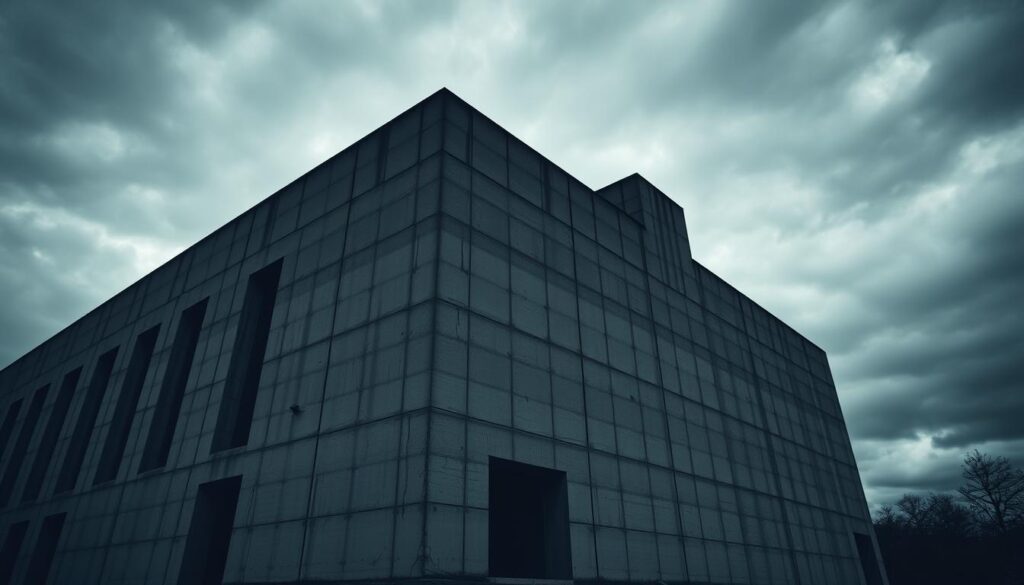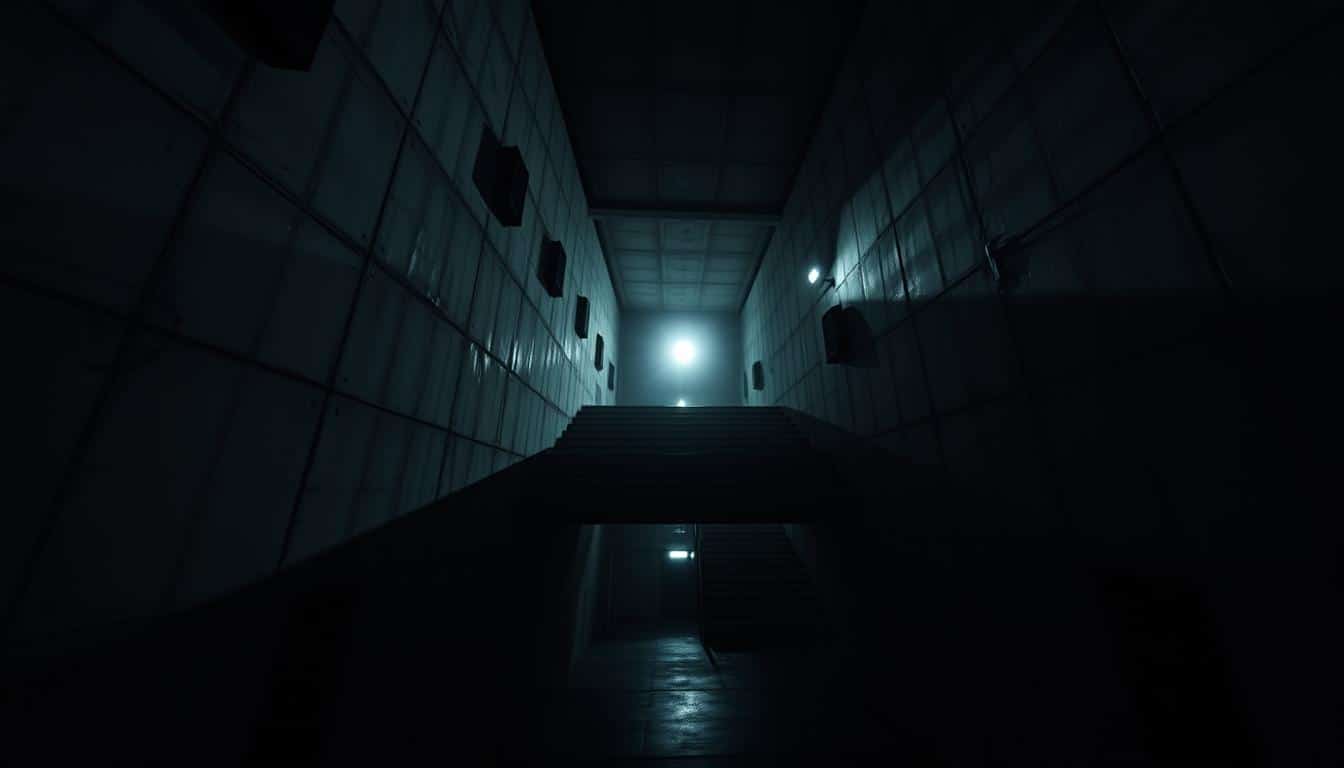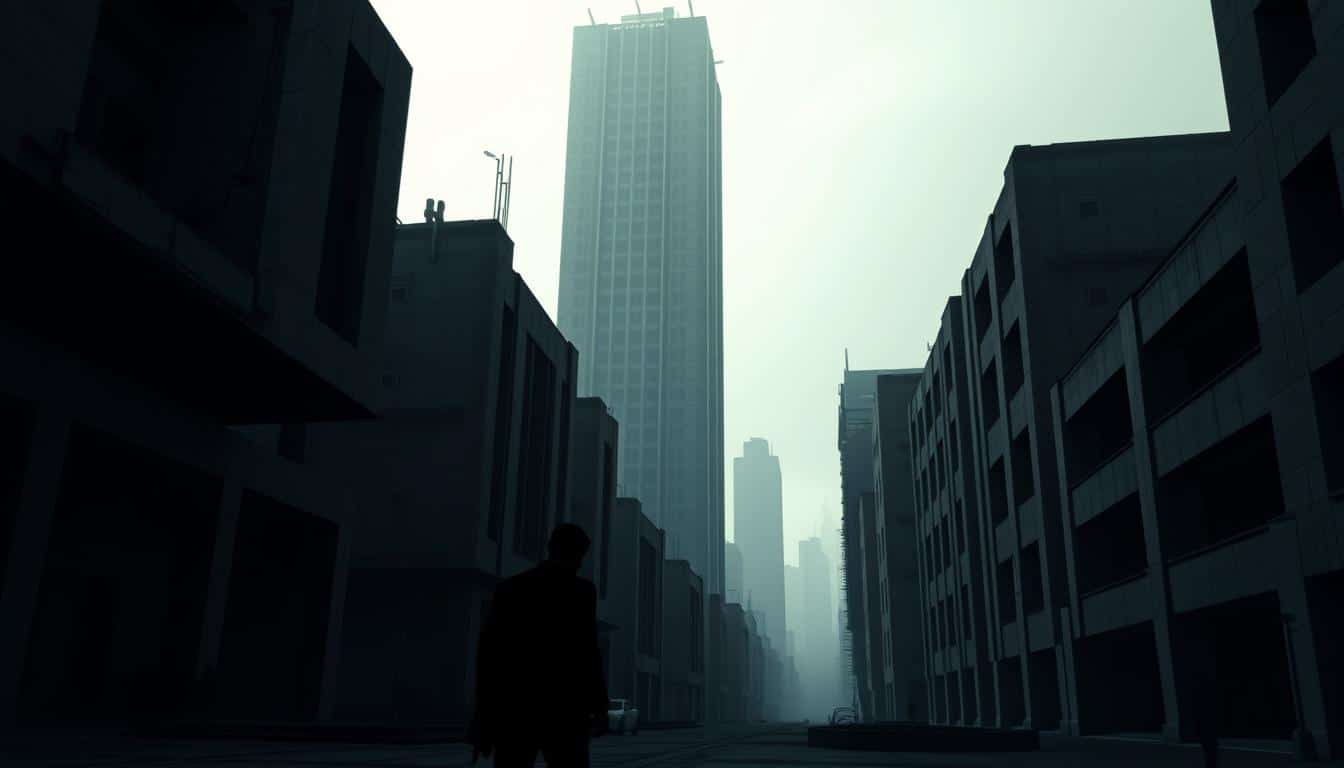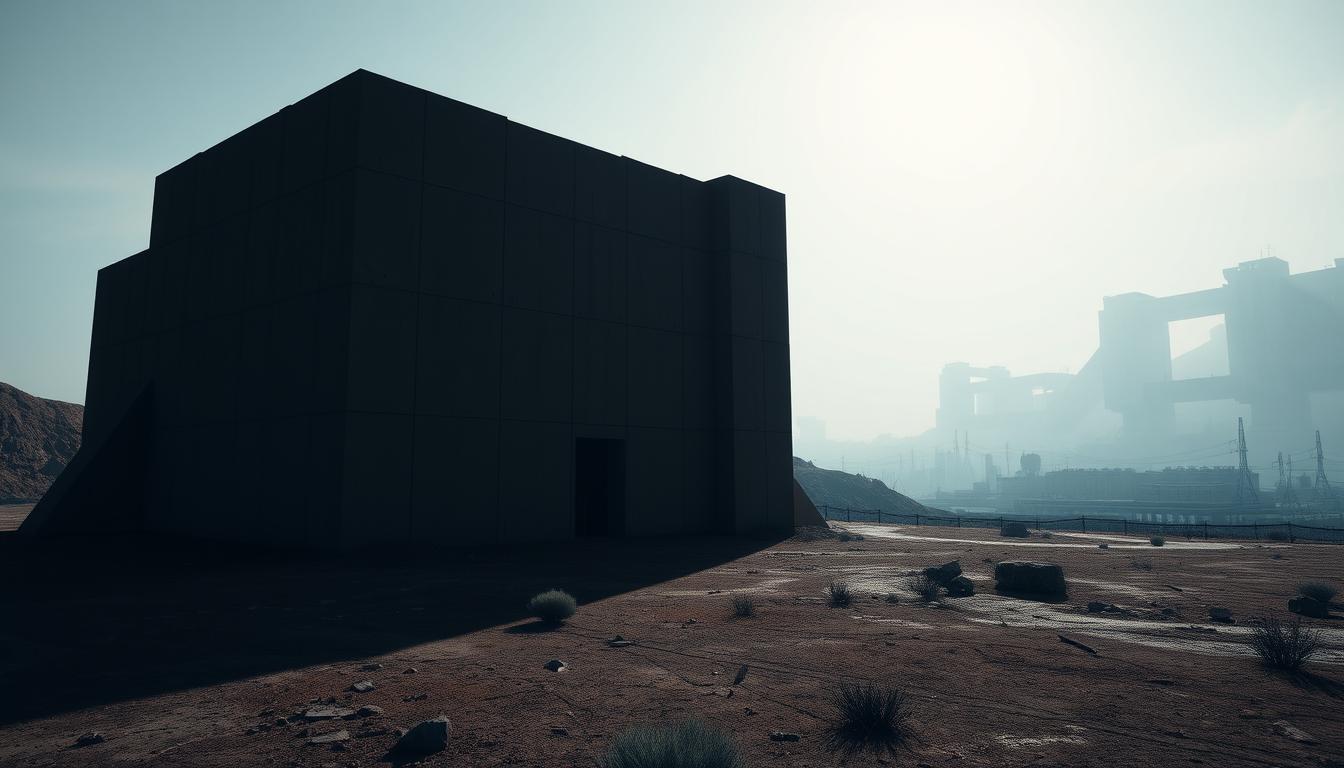Brutalist architecture uses raw concrete and big shapes. It’s important in psychological horror and tension in buildings. This style makes people feel mixed emotions, like awe and fear.
Brutalism is not just about the looks; it shows deep cultural and political ideas. It’s a great way for psychological horror to come to life. We’ll see how Brutalism’s bold design affects cities and art in movies and books. It deeply changes how we see architecture and our feelings.
The Essence of Brutalism
Brutalism is a unique architectural movement known for its boldness and raw materials use. It’s different because it shows raw honesty, unlike the ornate styles. Knowing its traits helps understand the strong feelings it stirs.
Defining Characteristics of Brutalist Architecture
Brutalism has key features that define it:
- Raw materials, particularly béton brut, which highlights the texture and integrity of concrete.
- Unadorned surfaces that reject embellishment, focusing instead on form and function.
- Stark geometric forms that create strong, powerful silhouettes against urban backdrops.
- A sense of massiveness, often leading to a monumental presence in the landscapes they occupy.
Brutalist architecture stands out by rejecting past styles. It favors utility and honesty over decoration and excess.
Historical Context and Emergence
Brutalism began after World War II, marked by socio-political changes. It aimed to reflect community values and progress in its designs. Many projects started in socialist settings aimed for a stable future. This focus on function and community identity made Brutalism a symbol of those times.

Brutalism as a Cultural Symbol
Brutalism became popular when social changes were happening, especially in Eastern Europe. It matched socialist ideals, showing off their hope for togetherness. Brutalist buildings stood for unity and toughness, making a strong point amid chaos.
Connections to the Socialist Movement
Brutalism linked closely with socialism, aiming to reshape cities with shared values. It made buildings that were practical and fostered community spirit. The style’s simplicity carried a deep message, reflecting the era’s beliefs.
Brutalism in Popular Culture and Art
Brutalism’s impact goes beyond buildings to influence arts like movies, music, and writing. It has touched filmmakers, musicians, and authors, marking its presence in pop culture. Directors use Brutalist settings for tension, while music videos feature them to suggest solitude or fear. This style continues to engage and challenge, fueling debates on culture and identity.
How Brutalism Fosters Tension and Psychological Horror
Brutalism’s look often makes people feel uneasy because of its heavy use of raw concrete. This rough material is a big part of Brutalism. It adds a dense atmosphere filled with beauty and fear.
The Psychological Impact of Raw Concrete
Raw concrete in buildings can make an environment feel unsettling, causing fear or anxiety. Its stark look and huge size can overtake city views, making places feel unfriendly. This can lead to strong reactions as the cold surfaces seem to take away any sense of warmth. This mix of feelings ties deeply to the horror that architecture can provoke.
The size of Brutalist buildings can make people feel small or unimportant. This challenges how we connect with our surroundings.
Architectural Forms and Their Emotional Responses
How we feel about Brutalist buildings can change a lot, based on individual backgrounds and culture. Moving through these large structures, the tension can spark different psychological reactions. Some might feel scared by their towering presence, while others could question their presence in such a stark environment.
This mixed feeling about Brutalist architecture shows the deep link between building design and our emotions.
Brutalism in Film and Literature
Brutalist architecture has a big impact on film and literature, especially in horror. Concrete structures with their stark look bring out feelings of terror, loneliness, and control. They are used in horror films and books to create a strong sense of fear. This mirrors our emotions and society’s challenges.
Depictions of Brutalist Structures in Horror Films
Brutalist buildings play a big role in adding tension to horror movies. These buildings create a sense of doom, reflecting what the characters feel inside. Films featuring Brutalism make places seem full of danger, making us feel more anxious. Some key aspects of these movies are:
- Visuals that make you feel trapped in small spaces
- A mix of clean architectural lines with messy human feelings
- Symbols of power and control seen in daunting designs
Literary References to Brutalism and Fear
In books, Brutalism is often linked to how it makes people feel scared and alone. Writers talk about how cold and uninviting these buildings are to show vulnerability. Stories in horror literature dealing with architecture focus on fear and our minds’ dark sides. Common themes in these stories are:
- Comparing buildings to mental states with metaphors
- Writing that makes you uncomfortable with stiff designs
- Stating how these spaces mirror being cut off from society and feeling alone
The Monolithic Presence of Brutal Structures
Brutalist architecture stands out with its bold designs. It shapes how communities see themselves and their Brutalism. These large buildings mix admiration with fear among the people. People see the huge impact of these buildings, yet they also feel an odd distance from them.
Impacts on Community and Identity
Brutalist landmarks and towns share a complex bond. They symbolize growth and new beginnings from their spots in the sky. But, their big size can hide the personal tales of people, causing a feeling of being lost. Even places meant for coming together can end up making people feel apart.
The Dichotomy of Awe and Dread
People have mixed feelings towards Brutalist buildings. They admire the creativity and effort but might also feel scared. These buildings make people feel strong and small at the same time. They show power but can also make us feel controlled, making us rethink our views on space and togetherness.
Brutalism’s Association with Authority and Control
Brutalism is closely linked with the ideas of authority and control in our societies. This style is known for its stark, rough designs and was used by governments to show power. By choosing Brutalism, they wanted to demonstrate their strength and control, making buildings that represent rules and authority.
These architectures serve as symbols of power, turning simple structures into massive fortresses. They force people to follow and obey, showing the power of those in charge.
Architecture as a Tool of Statecraft
Architecture often symbolizes government control. Brutalism shows how architectural styles reflect a government’s values and goals. These buildings are not just places; they represent the political climate of their time.
With their strong materials and sharp shapes, they make a bold statement. They tell us that these buildings are not just practical. They are also tools of power.
Brutalism’s Role in Depicting Authoritarian Spaces
Authoritarian regimes use Brutalism’s stark style to make people feel small and controlled. Huge, intimidating structures press the idea of submission and fear. In these places, a person’s sense of self can feel less important.
This architecture emphasizes a clear power hierarchy, with concrete and steel constantly reminding everyone who’s in control. As Brutalism becomes a symbol of suppression, it influences how we see authority and fear in our society.
Brutalism and Science Fiction
Brutalism in science fiction explores humanity’s future. This style shows the tough aspects of societal progress. It uses a visual language that engages and challenges people. Filmmakers and writers use Brutalism to talk about the future, mixing the known with the unknown.
Comparative Analysis with Sci-Fi Aesthetics
The big shapes of Brutalist architecture fit well in science fiction. Filmmakers use these buildings to create feelings of wonder and unease. Brutalism’s bold lines and raw materials echo alien looks in films. This creates a strong setting for stories about dystopian futures.
Movies like “Blade Runner” show Brutalist influences well. They make a setting that questions modern life and technology. They also create unforgettable visual scenes.
How Brutalism Evokes Alienness in Cinema
Brutalism makes movies feel alien. It contrasts human life with cold concrete and sharp designs. By showing these huge buildings, filmmakers point out how people might feel lost as society changes. Brutalism helps viewers think about identity, technology, and what it means to be human.
The Legacy of Brutalism in Urban Spaces
Brutalism’s legacy shapes how we see and feel in our cities. It reflects the complex issues of modern urban life. As cities grow, Brutalism’s impact deepens, critiquing and supporting urban living.
Urban Infrastructure and Its Affects on Mental Health
The tie between mental health and city design highlights Brutalism’s deep effects. Its bold, concrete forms can make people feel alone or disconnected. This shapes how communities come together or fall apart.
Designers now think about mental health and urban infrastructure together. They’re looking at Brutalism in a new way. Important aspects they consider are:
- The visual impact of large Brutalist structures
- How architecture influences our mental state
- How safe and comfortable people feel in these spaces
Brutalism as a Reflective Surface of Modernity
Brutalism mirrors the ideas of Brutalism and modernity. It shows our struggles with function and community in architecture. Brutalist designs wanted to improve public life with clear social goals, but reality often conflicted.
These enduring buildings start conversations between their looks and intentions. They let urban areas show their history and today’s issues. The key points of this discussion include:
- How design mixes usefulness with beauty
- The way Brutalist architecture affects our lives
- How buildings influence community dynamics
Personal Experiences and the Emotional Landscape of Brutalism
People feel differently about Brutalist architecture. Some love it, while others don’t. Its emotional impact often comes from its bold look. Many find the bare, strong nature of these buildings draws them in. It makes them feel more connected to their surroundings.
Subjective Reactions to Brutalist Architecture
How we see Brutalism varies from person to person. For some, it brings back memories, for others, it makes them uneasy. What influences these views include:
- The size and shape of the buildings, which can amaze or overwhelm.
- The materials used, creating emotional ties through touch.
- Personal memories that shape how we view these structures.
Photographic Representations and Their Interpretations
Photos bring a unique perspective to Brutalist buildings. They capture the beauty and challenges of Brutalism. Through photos, we can explore various views and start exciting conversations about the role of these buildings in our lives. Key points include:
- How light plays with concrete, changing how we feel about a place.
- Different ways of framing that highlight or downplay a building’s impact.
- Angles and shots that stir emotions in us.
Conclusion
Our journey into Brutalism shows its key role in creating architectural tension and horror. It shapes our personal and group experiences deeply. Brutalism brings together raw concrete and our psychological reactions. It stands out in movies and books, amplifying our societal fears.
Brutalism is more than just buildings; it’s a conversation about who we are and the power around us. It reflects our worries and hopes, showing how spaces affect our minds. Its influence stretches into modern talks, shaping future research on architecture’s impact on our culture and emotions.



